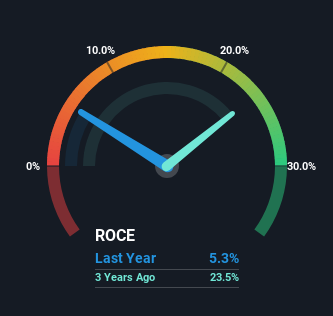- Hong Kong
- /
- Basic Materials
- /
- SEHK:914
Investors Could Be Concerned With Anhui Conch Cement's (HKG:914) Returns On Capital

If we want to find a potential multi-bagger, often there are underlying trends that can provide clues. Amongst other things, we'll want to see two things; firstly, a growing return on capital employed (ROCE) and secondly, an expansion in the company's amount of capital employed. Basically this means that a company has profitable initiatives that it can continue to reinvest in, which is a trait of a compounding machine. In light of that, when we looked at Anhui Conch Cement (HKG:914) and its ROCE trend, we weren't exactly thrilled.
Return On Capital Employed (ROCE): What Is It?
Just to clarify if you're unsure, ROCE is a metric for evaluating how much pre-tax income (in percentage terms) a company earns on the capital invested in its business. The formula for this calculation on Anhui Conch Cement is:
Return on Capital Employed = Earnings Before Interest and Tax (EBIT) ÷ (Total Assets - Current Liabilities)
0.053 = CN¥12b ÷ (CN¥245b - CN¥26b) (Based on the trailing twelve months to March 2024).
Thus, Anhui Conch Cement has an ROCE of 5.3%. On its own that's a low return on capital but it's in line with the industry's average returns of 5.1%.
View our latest analysis for Anhui Conch Cement

Above you can see how the current ROCE for Anhui Conch Cement compares to its prior returns on capital, but there's only so much you can tell from the past. If you'd like, you can check out the forecasts from the analysts covering Anhui Conch Cement for free.
What The Trend Of ROCE Can Tell Us
In terms of Anhui Conch Cement's historical ROCE movements, the trend isn't fantastic. Around five years ago the returns on capital were 31%, but since then they've fallen to 5.3%. Meanwhile, the business is utilizing more capital but this hasn't moved the needle much in terms of sales in the past 12 months, so this could reflect longer term investments. It's worth keeping an eye on the company's earnings from here on to see if these investments do end up contributing to the bottom line.
What We Can Learn From Anhui Conch Cement's ROCE
To conclude, we've found that Anhui Conch Cement is reinvesting in the business, but returns have been falling. And in the last five years, the stock has given away 44% so the market doesn't look too hopeful on these trends strengthening any time soon. On the whole, we aren't too inspired by the underlying trends and we think there may be better chances of finding a multi-bagger elsewhere.
One more thing to note, we've identified 1 warning sign with Anhui Conch Cement and understanding this should be part of your investment process.
If you want to search for solid companies with great earnings, check out this free list of companies with good balance sheets and impressive returns on equity.
New: Manage All Your Stock Portfolios in One Place
We've created the ultimate portfolio companion for stock investors, and it's free.
• Connect an unlimited number of Portfolios and see your total in one currency
• Be alerted to new Warning Signs or Risks via email or mobile
• Track the Fair Value of your stocks
Have feedback on this article? Concerned about the content? Get in touch with us directly. Alternatively, email editorial-team (at) simplywallst.com.
This article by Simply Wall St is general in nature. We provide commentary based on historical data and analyst forecasts only using an unbiased methodology and our articles are not intended to be financial advice. It does not constitute a recommendation to buy or sell any stock, and does not take account of your objectives, or your financial situation. We aim to bring you long-term focused analysis driven by fundamental data. Note that our analysis may not factor in the latest price-sensitive company announcements or qualitative material. Simply Wall St has no position in any stocks mentioned.
About SEHK:914
Anhui Conch Cement
Manufactures, sells, and trades in clinker and cement products in China and internationally.
Very undervalued with excellent balance sheet and pays a dividend.
Market Insights
Community Narratives



